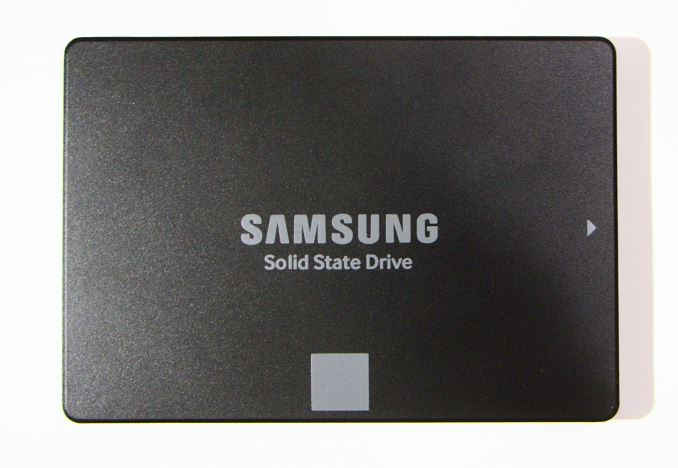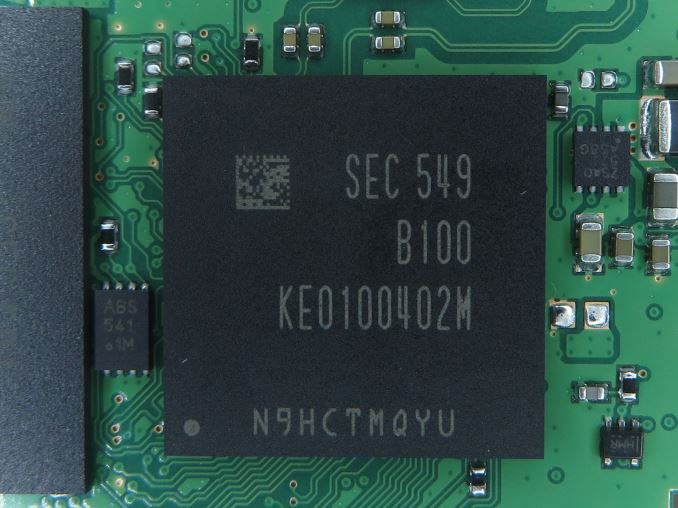The Samsung 750 EVO (120GB & 250GB) SSD Review: A Return To Planar NAND
by Billy Tallis on April 22, 2016 8:00 AM EST
Since the introduction of their first consumer TLC SSD with the SSD 840, Samsung's consumer/retail SATA SSD lineup has consisted of two product families: the MLC-based Pro drives, and the TLC-based 840 and EVO drives. The strength of Samsung's SSD controllers and the advantages of 3D NAND have allowed the 850 EVO to maintain a solidly mid-range position in the SSD market well above any other drive using TLC NAND.
Meanwhile, with the strength of the 850 EVO as a near-midrange product - and with pricing to match - like so many other vendors over the last year, Samsung has also been developing a true low cost TLC drive for the mass market. The end result is the Samsung 750 EVO, which we're revieiwng today. The 750 EVO establishes a new budget-oriented product line that competes in the cutthroat low end of the market where price per GB is the most important aspect of the product.
There are several design choices that help minimize the cost of the 750 EVO, aside from the obvious choice of TLC over MLC. The MGX controller it borrows from the lower capacity 850 EVOs is a dual-core version of Samsung's usual triple-core architecture. Similarly, the 750 EVO is only available in 120GB and 250GB sizes, so there is no high-priced high capacity model. Consequently, with only two small capacities, the 750 EVO line is served by a single tiny PCB layout, made even smaller by the fact that Samsung has put the 256MB of DRAM in the same package as the SSD controller.

Samsung MGX controller with onboard 256MB DRAM
But the most significant aspect of the 750 EVO is that it doesn't use the 3D NAND that has been a key competitive advantage for Samsung's 850 product lines. Samsung has continued development of planar NAND even after transitioning their retail SSDs to 3D NAND, and the 750 EVO in turn uses 16nm planar TLC. It doesn't offer the same performance or endurance of Samsung's 3D NAND, but it does significantly lower the cost of the drive.

128GB of 16nm TLC NAND in a single package
The 16nm TLC NAND is the successor to Samsung's 19nm TLC that had a troubled tenure in the 840 EVO. With the 840 EVO, data at rest on the drive degraded over time and eventually required the use of more thorough and thus slower error correction when read back. As a result the 750 EVO inherits the benefits of all the firmware work Samsung did to mitigate the read speed degradation. This, for what it's worth, gives Samsung some degree of a leg-up against other 16/15nm TLC drives that face the same challenges.
| Samsung TLC SATA SSD Comparison | |||||
| Drive | 750 EVO 120GB | 750 EVO 250GB | 850 EVO 120GB | 850 EVO 250GB | |
| Controller | MGX | MGX | |||
| NAND | Samsung 128Gb 16nm TLC | Samsung 32-layer 128Gbit TLC V-NAND | |||
| DRAM | 256MB | 256MB | 256MB | 512MB | |
| Sequential Read | 540MB/s | 540MB/s | 540MB/s | 540MB/s | |
| Sequential Write | 520MB/s | 520MB/s | 520MB/s | 520MB/s | |
| 4KB Random Read | 94K IOPS | 97K IOPS | 94K IOPS | 97K IOPS | |
| 4KB Random Write | 88K IOPS | 88K IOPS | 88K IOPS | 88K IOPS | |
| 4KB Random Read QD1 | 10K IOPS | 10K IOPS | 10K IOPS | 10K IOPS | |
| 4KB Random Write QD1 | 35K IOPS | 35K IOPS | 40K IOPS | 40K IOPS | |
| DevSleep Power | 6mW | 2mW | |||
| Slumber Power | 50mW | 50mW | |||
| Active Power (Read/Write) | 2.1W / 2.4W (Average) | 2.4W / 2.8W (Average) | Max 3.7W / 4.4W | ||
| Encryption | AES-256, TCG Opal 2.0, IEEE-1667 (eDrive) | AES-256, TCG Opal 2.0, IEEE-1667 (eDrive) | |||
| Endurance | 35TB | 70TB | 75TB | ||
| Warranty | Three years | Five years | |||
By and large the performance specifications for the 750 EVO match the lower capacity 850 EVO, though a slightly lower random write speed at a queue depth of one hints that the 750 EVO may require a bit more background wear leveling work. The feature set is identical to the 850 EVO, making the 750 EVO one of the few low-end drives to support TCG Opal encryption.
Samsung's marketing strategy for the 750 EVO is a little different from their previous retail SSD products. The 750 EVO is targeted specifically at system integrators and system builders, rather than at users looking to upgrade an existing machine. Consequently, they aren't pushing to make the 750 EVO available from as wide a range of retail outlets. Enough of the major online retailers have it in stock that it is not difficult to obtain.
This review will focus on comparing the 750 EVO against Samsung's other SATA SSDs and against other current-generation low-end TLC SSDs of comparable capacity. Our Bench tool can assist in making other comparisons.
| AnandTech 2015 SSD Test System | |
| CPU | Intel Core i7-4770K running at 3.5GHz (Turbo & EIST enabled, C-states disabled) |
| Motherboard | ASUS Z97 Pro (BIOS 2701) |
| Chipset | Intel Z97 |
| Memory | Corsair Vengeance DDR3-1866 2x8GB (9-10-9-27 2T) |
| Graphics | Intel HD Graphics 4600 |
| Desktop Resolution | 1920 x 1200 |
| OS | Windows 8.1 x64 |
- Thanks to Intel for the Core i7-4770K CPU
- Thanks to ASUS for the Z97 Deluxe motherboard
- Thanks to Corsair for the Vengeance 16GB DDR3-1866 DRAM kit, RM750 power supply, Carbide 200R case, and Hydro H60 CPU cooler










109 Comments
View All Comments
Ascaris - Thursday, April 28, 2016 - link
Isn't that the truth! Nearly every item comes with glowing reviews mixed in with "mine died in xx time, and I am never going to buy from $company ever again." Consumer routers and hard drives seem particularly bad in that way-- if I avoided all of the ones with horror stories, I'd never have either of them.Another thing people tend to overlook in reliability is the role of a good power supply. A cheap PSU can slowly sap the life from all the components in the system by introducing unacceptable levels of ripple, and you'd never know that was a cause or partial cause of the failure. On a laptop with the brick-style power supply, it is a good idea to replace a failed unit with an OEM unit of recent manufacture (less chance of dried-up caps) than some eBay special of unknown origin (other than to say China, which is where the OEM one came from too, almost certainly).
For desktops, the PSU is something people sometimes skimp on. I've never actually had a prebuilt desktop, but I would bet a lot of them have cheap PSUs, as it is probably a place where pennies can be pinched without a huge increase in RMAs before the warranty expires. I looked at new PCs on the site of one of the major online sellers about a year ago, and I was surprised at how many current models still had 120/240v switches on the PSU, which shows that they are older models without active PFC. That does not necessarily mean they're of poor quality, but it does make me wonder about them.
BrokenCrayons - Friday, April 22, 2016 - link
I think it needs to come down in price before it'll be an acceptable sort of purchase.zepi - Friday, April 22, 2016 - link
SSD's have lost a lot by being so hamstrung by their interfaces. CPU's have limited number of PCI-e connections and motherboards very little space for M.2 slots. SATA 3 is slow and bad protocol for SSD so that race to the bottom is only thing that is of any interest in 2.5" drives.TheinsanegamerN - Friday, April 22, 2016 - link
SATA 3 may not be super fast, but the only observable difference, IME, between an m.2 drive and a sata drive was 2 seconds on boot. Unless you are a content creator working with laarge video/pictures, m.2 has little to offer over sata.Especially given that 2TB sata ssds exist, while m.2 is limited to 512GB, and that 512GB m.2 is more expensive than a 1TB sata ssd. And the ehat that m.2 drives give off compared to sata.
Margalus - Friday, April 22, 2016 - link
It may be "cheap", but it's worthless in my opinion. Only 120GB or 250GB, pretty much too small for anything except a boot drive. If there are no 1TB drives, why bother?TheinsanegamerN - Friday, April 22, 2016 - link
Believe it or not, many people could fit their computer needs in 250GB.I only use about 500GB between all of the games I actually play, and the OS itself.
Meteor2 - Friday, April 22, 2016 - link
Mmmm, I think a lot of people have digital media collections now. I have no DVDs or Blu Rays, but 600 GB of films and TV series.barleyguy - Friday, April 22, 2016 - link
Video doesn't need SSD levels of performance. Any modern spinning disk is fast enough to play video, even up to 4K.Personally, my video server machine is a 250 GB MX200 M-SATA SSD and a 4 TB hard drive.
Meteor2 - Saturday, April 23, 2016 - link
Absolutely but I want a single high-performance disc.Bleakwise - Sunday, April 24, 2016 - link
Why do you want an SSD for cold storage backups? That's just silly.